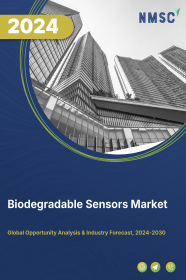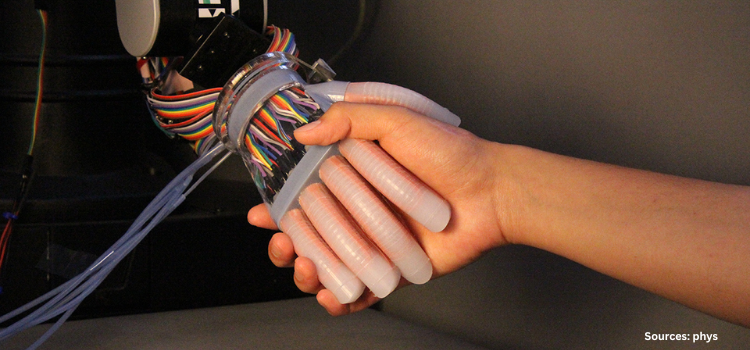
Biodegradable Sensors Market by Type (Temperature Sensors, Humidity Sensors, Pressure Sensors, Gas Sensors, Biosensors, Others), by Application (Healthcare, Agriculture, Logistics, Food & Beverage, Wearable Electronics, Industrial Process Manufacturing, Research & Development, Environmental Monitoring, and Others) – Global Opportunity Analysis and Industry Forecast 2022-2030
US Tariff Impact on Biodegradable Sensors Market
Trump Tariffs Are Reshaping Global Business
Market Definition
The global Biodegradable Sensors Market was valued at USD 90.12 million in 2021 and is predicted to reach USD 2,053.5 million by 2030 with a CAGR of 41.8% from 2022-2030. Biodegradable sensors are electronic devices that are designed to perform sensing functions and are constructed using materials that can naturally degrade over time. These sensors are made from biodegradable substances such as biopolymers or natural fibers, which allows them to break down and decompose in the environment through natural processes.
Biodegradable sensors offer an environmentally friendly alternative to traditional sensors, as they minimize electronic waste and reduce the long-term impact on the ecosystem. These sensors find applications in various industries including healthcare, agriculture, environmental monitoring, and more, where their temporary usage and eco-friendly nature are advantageous.
Market Dynamics and Trends
The growing awareness and concern for environmental sustainability, as consumers and businesses are increasingly prioritizing eco-friendly solutions to reduce their environmental impact, is driving the growth of the biodegradable sensors market.
Moreover, stringent regulations from governments and regulatory bodies worldwide to curb electronic waste and encourage the adoption of sustainable alternatives is boosting the biodegradable sensors market growth. Furthermore, advancements in sensor technology have led to improvements in the performance and reliability of these sensors, making them suitable for a wide range of applications, further fostering the growth of the market.
However, the high cost of development and lack of proper knowledge of these sensors are expected to restrain the growth of the market during the forecast period. On the other hand, advancements in innovative technologies such as bio-interfacing and biodegradable flexible hybrid electronics (FHE) sensors are expected to drive the market in the future. These sensors help in measuring and analyzing complex biogenic substances such as breath, sweat, blood, and urine and are thereby expected to create lucrative growth opportunities for the biodegradable sensor market players in the future.
Market Segmentations and Scope of the Study
The biodegradable market share is segmented based on sensor type, application, and geography. On the basis of sensor type, the market is segmented into temperature sensors, humidity sensors, pressure sensors, gas sensors, biosensors, others. Based on application, the market is classified into healthcare, agriculture, logistics, food & beverage, wearable electronics, industrial process manufactuiring, research & development, Environmental monitoring, and others.
Healthcare sector is further divided into patient monitoring, continuous blood pressure monitoring, implantable loop recorder, cardiac monitoring electrode, pulse oximeter, smart pill, continuous blood glucose monitoring, diagnostics, capsule endoscopes, and HIV test strip sensors. Agriculture is further classified into soil sensing, crop health monitoring, water management, precision agriculture, crop yield optimization, pest and disease management. Logistics is further divided into temperature monitoring, humidity monitoring, vibration monitoring, location tracking, shock detection, light exposure monitoring, gas and air quality monitoring, package integrity monitoring, time and date stamp, tamper detection. Food & beverage is further segmented into quality control, shelf-life monitoring, temperature monitoring, humidity monitoring, gas and air quality monitoring, contamination detection, spoilage detection, supply chain traceability, packaging integrity monitoring, product authentication. The geography breakdown and analysis of each of the aforesaid segments includes regions comprising North America, Europe, Asia-Pacific, and RoW.
Geographical Analysis
Asia Pacific held the lion’s share of the global biodegradable sensors market and is expected to continue dominating the market during the forecast period. This is attributed to factors such as increasing incidences of chronic diseases such as cancer and rising concern over contagion and hospital-acquired Infections In addition, a rise in demand for low-cost medical devices and utilization of implantable sensors in preclinical drug research are further anticipated to propel the demand in this region.
Moreover, the robust agricultural industry in Asia Pacific, characterized by extensive farming practices and a wide range of crops, has created a strong demand for advanced technologies including biodegradable sensors for soil sensing, crop health monitoring, and water management. According to the latest report published by the National Bureau of Statistics of China in 2022, the agriculture and related industries in China contributed 16.47 percent in China’s GDP in 2020, with total added value amounted to USD 2553 billion.
The market across North America is expected to show a steady rise in the biodegradable sensors industry. The presence of advanced medical facilities, research institutions, and increased healthcare expenditure, the healthcare industry in North America has created a strong demand for cutting-edge technologies such as biodegradable sensors for patient monitoring, diagnostics, and implantable devices to improve patient care and provide accurate diagnostics. According to the Centers for Medicare & Medicaid Services, national healthcare expenditure reached 4.3 trillion in 2021 in the United States as compared to 4.1 trillion in 2020.
Moreover, the growing environmental concern, supported by stringent government policies to reduce carbon emissions and carbon footprint, significantly contributed to the growth of the biodegradable sensors market in this region.
Competitive Landscape
The biodegradable sensors industry comprises various market players such as Aldrich Corporation, Bayer Material Science AG, Merck Kgaa, Elsys, AU Optronics Corporation, Evonik Industries, Asahi Kasei Corporation, BASF SE, Samsung Display, and Novaled among others. These manufacturers are actively indulging in R&D initiatives, product & technology innovations, and industrial collaborations to enhance their products and increase their sales growth and geographical reach. For instance, in March 2022, ELSYS launched ERS Eco battery-free sensors line. The environmentally friendly sensor line includes two sensor types known as ERS Eco and ERS Eco CO2. These sensors are powered by Epishine’s indoor solar cells and are made from biodegradable materials.
Key Benefits
-
The biodegradable sensors market report provides a quantitative analysis of the current market estimations, throughout 2022-2030 that assist in identifying the prevailing market opportunities to capitalize on.
-
The study comprises a deep dive analysis of the global biodegradable sensors market, including the current and future trends for depicting the prevalent investment pockets in the market.
-
The information related to key drivers, restraints, and opportunities and their impact on the market is provided in the report.
-
The competitive analysis of the market players along with their market share in the industry, is mentioned.
-
The SWOT analysis and Porter’s Five Forces model are elaborated on in the study.
-
Value chain analysis in the market study provides a clear picture of the stakeholders’ roles.
Biodegradable Sensors Market Key Segments
By Type
-
Temperature Sensors
-
Humidity Sensors
-
Pressure Sensors
-
Gas Sensors
-
Biosensors
-
Others
By Application
-
Healthcare
-
Agricultural
- Logistics
-
Food & Beverage
-
Wearable Electronics
-
Industrial Process Manufacturing
-
Research & Development
-
Environmental Monitoring
-
Others
By Geography
-
North America
-
U.S
-
Canada
-
Mexico
-
-
Europe
-
Germany
-
France
-
Italy
-
Spain
-
United Kingdom
-
Russia
-
Sweden
-
Rest of Europe
-
-
Asia-Pacific
-
Australia
-
China
-
India
-
Japan
-
South Korea
-
Indonesia
-
Singapore
-
Rest of Asia-Pacific
-
-
RoW
-
Latin America
-
Middle East
-
Africa
-
Key Players
-
Aldrich Corporation
-
Bayer Material Science AG
-
Merck KGaA
-
Epshine
-
Evonik Industries
-
Corbion N.V.
-
DSM
-
BASF SE

















 Speak to Our Analyst
Speak to Our Analyst




















